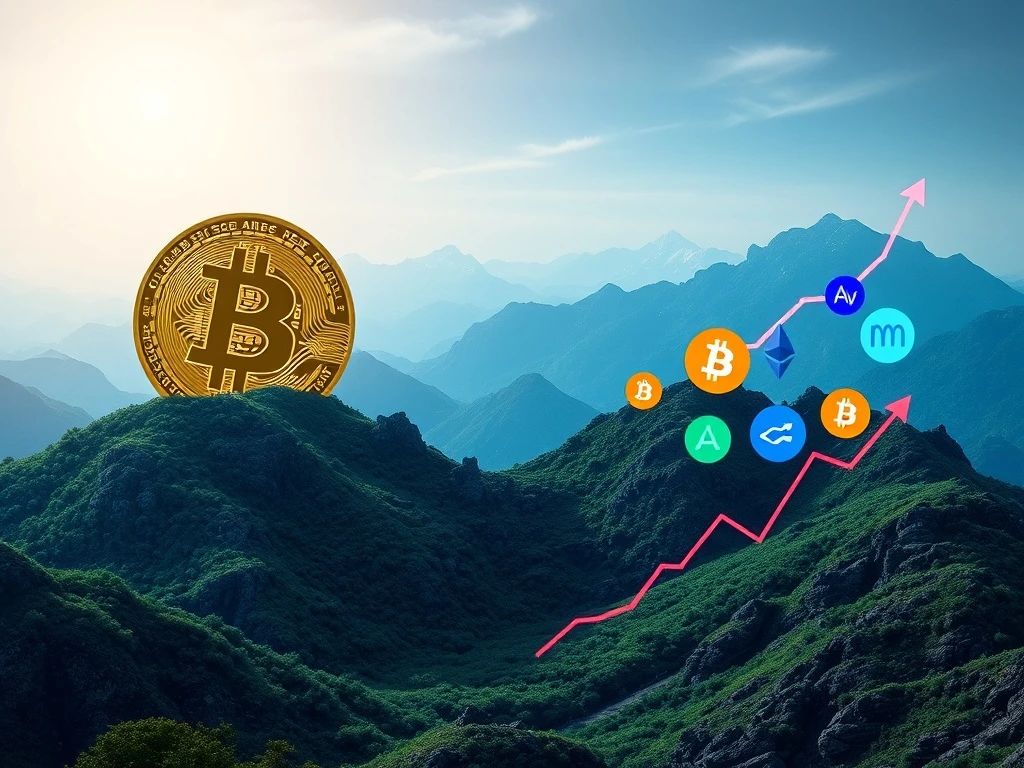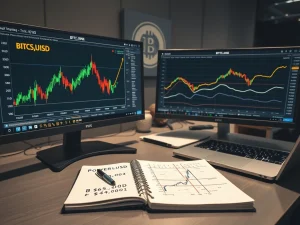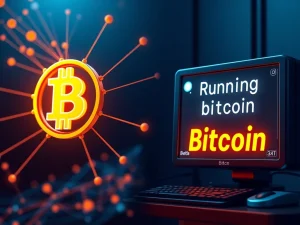Unleashing the Altcoin Surge: Bitcoin Dominance Plummets to 61% Amidst Crypto Market Shift

The cryptocurrency landscape is undergoing a significant transformation. For years, Bitcoin has held an unshakeable grip on the market, dictating trends and absorbing the lion’s share of capital. However, recent data suggests a compelling shift: Bitcoin dominance is waning, paving the way for a remarkable altcoin surge. This pivotal moment is reshaping investment strategies and opening new avenues for growth within the broader crypto market.
Bitcoin Dominance Redefines Market Dynamics: What’s Happening?
For a long time, Bitcoin’s market capitalization represented the overwhelming majority of the total crypto market. This dominance often meant that when Bitcoin moved, the rest of the market followed. However, a notable trend has emerged: Bitcoin’s market share has recently dropped to 61%. This decline is a key indicator of shifting investor sentiment and capital reallocation. Data from July 2025 shows a 2.6% growth in total crypto capitalization, a significant portion of which is being driven by non-BTC assets.
This shift isn’t entirely new; historical patterns often show reduced Bitcoin dominance triggering capital inflows into altcoins. The current re-emergence of this trend suggests a maturing market where investors are increasingly comfortable exploring beyond the foundational cryptocurrency. The TOTAL3 index, which tracks altcoins excluding Bitcoin and Ethereum, has become a critical barometer for this performance, with analysts forecasting continued gains as funds rotate out of BTC.
The Altcoin Surge: Spotlighting Key Players
The recent altcoin surge has been particularly pronounced in several prominent tokens, demonstrating their growing appeal and utility. While Bitcoin’s gains have been relatively muted, altcoins like Ethereum (ETH), Solana (SOL), and XRP have shown impressive momentum.
- Ethereum (ETH): Institutional demand for Ethereum has surged, reflecting its critical role in the decentralized finance (DeFi) and NFT ecosystems. Despite a brief dip below $3,700 in July, Ethereum continues to be a blue-chip altcoin, often leading the charge in broader market rallies. The anticipation around future upgrades and its robust ecosystem fuels continued interest.
- XRP: XRP reached record highs in July 2025, buoyed by recent regulatory developments. Clarity surrounding a spot XRP ETF and positive US policy updates have significantly boosted institutional confidence, positioning XRP as a strong contender for further gains.
- BNB: Binance Coin (BNB) also hit new record highs in July 2025, showcasing the strength of exchange-backed tokens and their utility within large crypto ecosystems.
- Solana (SOL): Retail investor interest has notably surged, pushing tokens like Solana into the spotlight. Its high transaction throughput and growing developer community make it an attractive option for those seeking scalable blockchain solutions.
This widespread performance across various altcoins underscores a diversified market where specific narratives and technological advancements are driving distinct rallies.
Navigating the Dynamic Crypto Market: Institutional vs. Retail Flows
The current crypto market cycle is characterized by a fascinating divergence in strategies between institutional and retail investors. This interplay adds layers of complexity and volatility to the market.
Institutional Caution:
- On-chain data reveals a slowing accumulation of BTC by institutional players, indicating waning demand for Bitcoin at current levels.
- This has prompted many funds to rebalance their portfolios, shifting capital towards altcoins, particularly within the DeFi and layer-1 blockchain sectors.
- Macroeconomic uncertainties and a cautious approach to large-cap assets contribute to this rebalancing.
Retail Optimism:
- In contrast, retail traders have amplified altcoin demand, citing renewed confidence in the sector.
- This enthusiasm is often driven by the potential for higher percentage gains in smaller, more volatile assets compared to Bitcoin’s more sideways movement.
- Social media trends and community-driven narratives often play a significant role in fueling retail interest in specific altcoins.
This divergence creates a fragmented market where outcomes hinge on Bitcoin’s consolidation and ongoing regulatory developments. While institutional caution might temper overall market exuberance, retail optimism provides a strong base for altcoin rallies.
Regulatory Clarity and the XRP ETF Impact
Regulatory developments are increasingly playing a pivotal role in shaping investor sentiment and capital flows within the crypto space. The recent clarity surrounding a spot XRP ETF is a prime example of how policy updates can significantly impact asset performance and institutional interest.
The approval or even clear guidance on such financial products can:
- Legitimize assets: An ETF provides a regulated, accessible avenue for traditional investors to gain exposure to a cryptocurrency without directly holding the asset.
- Boost institutional confidence: Regulatory clarity reduces uncertainty, making it safer for large institutions to allocate capital.
- Increase liquidity: Greater participation from institutional investors can lead to increased trading volume and market liquidity.
This development for XRP, alongside other US policy updates, is fueling broader institutional interest in non-BTC assets, suggesting that a more regulated and diverse crypto investment landscape is emerging.
Understanding Volatility and Risk in the Altcoin Market
While the altcoin surge presents exciting opportunities, it’s crucial to acknowledge the inherent volatility and risks associated with these assets. The market remains highly sensitive to sentiment shifts and macroeconomic factors.
In mid-July, over $200 million in altcoin-related liquidations were recorded as prices faltered. This highlights the speculative nature of many altcoin trades and the rapid unwinding of leveraged positions when the market turns. Smaller altcoins, in particular, face heightened exposure to these sentiment shifts and regulatory risks compared to the more established Bitcoin.
Analysts caution that while historical “altcoin seasons” often follow Bitcoin’s dominance peaks, the current cycle remains fragmented. The trajectory of altcoin performance will depend significantly on Bitcoin’s stability and broader macroeconomic conditions. If Bitcoin weakens below key support levels, such as $120,000, further liquidations could occur, potentially accelerating capital reallocation but also increasing overall market fragility.
Future Outlook: Will the Altcoin Momentum Continue?
The big question on everyone’s mind is whether the current altcoin surge is sustainable. The interplay between institutional caution and retail optimism will continue to shape the market’s trajectory. Tokens like XRP and BNB are positioned to test key resistance levels, suggesting potential for further gains if market conditions remain favorable.
However, investors must remain vigilant. The market’s speculative nature means that rapid price swings are always a possibility. Diversification, risk management, and staying informed about regulatory developments will be crucial for navigating this dynamic period. The current cycle, while exciting, demands a nuanced approach, recognizing both the immense potential and the significant risks involved.
The declining Bitcoin dominance and the accelerating altcoin surge signal a new chapter for the crypto market. While the path ahead may be volatile, the increased investor interest in diverse assets, driven by technological innovation and regulatory clarity, paints a picture of a more mature and complex ecosystem. As we move forward, the resilience of altcoins and Bitcoin’s ability to consolidate will be key determinants of the market’s overall health and direction. Investors should keep a close eye on the XRP ETF developments and the general Ethereum price movements as indicators of broader market sentiment.
Frequently Asked Questions (FAQs)
Q1: What does Bitcoin dominance mean, and why is its decline significant?
Bitcoin dominance refers to Bitcoin’s market capitalization as a percentage of the total cryptocurrency market capitalization. A decline in Bitcoin dominance indicates that altcoins (alternative cryptocurrencies) are gaining a larger share of the overall market. This is significant because it suggests a diversification of investor interest and capital beyond Bitcoin, often signaling an “altcoin season” where smaller cryptocurrencies see substantial growth.
Q2: Which altcoins are leading the current surge?
The current altcoin surge is being led by several prominent cryptocurrencies. Ethereum (ETH) is seeing increased institutional demand due to its robust DeFi and NFT ecosystem. XRP has reached record highs following positive regulatory developments, including discussions around a spot XRP ETF. Other notable performers include Solana (SOL) and BNB, driven by retail interest and strong ecosystem utility, respectively.
Q3: What factors are contributing to the shift from Bitcoin to altcoins?
Several factors are contributing to this shift. Waning institutional demand for Bitcoin at current price levels is prompting funds to rebalance portfolios towards altcoins. Retail investor interest has surged, seeking higher potential returns in more volatile assets. Additionally, regulatory clarity, such as the potential for a spot XRP ETF, is fueling institutional confidence in non-BTC assets, particularly in the DeFi and layer-1 blockchain sectors.
Q4: How volatile is the altcoin market, and what are the risks?
The altcoin market is inherently volatile. While it offers high reward potential, it also carries significant risks. Recent data shows over $200 million in altcoin-related liquidations in mid-July, highlighting the rapid price swings and potential for losses, especially for leveraged positions. Smaller altcoins are particularly susceptible to sentiment shifts and regulatory uncertainties compared to Bitcoin. Investors should be prepared for significant price fluctuations and consider robust risk management strategies.
Q5: What is the significance of a spot XRP ETF?
The potential approval of a spot XRP ETF (Exchange Traded Fund) is highly significant. An ETF would allow traditional investors to gain exposure to XRP through a regulated financial product without directly holding the cryptocurrency. This legitimizes the asset, boosts institutional confidence by reducing regulatory uncertainty, and could lead to increased liquidity and broader market participation for XRP.









